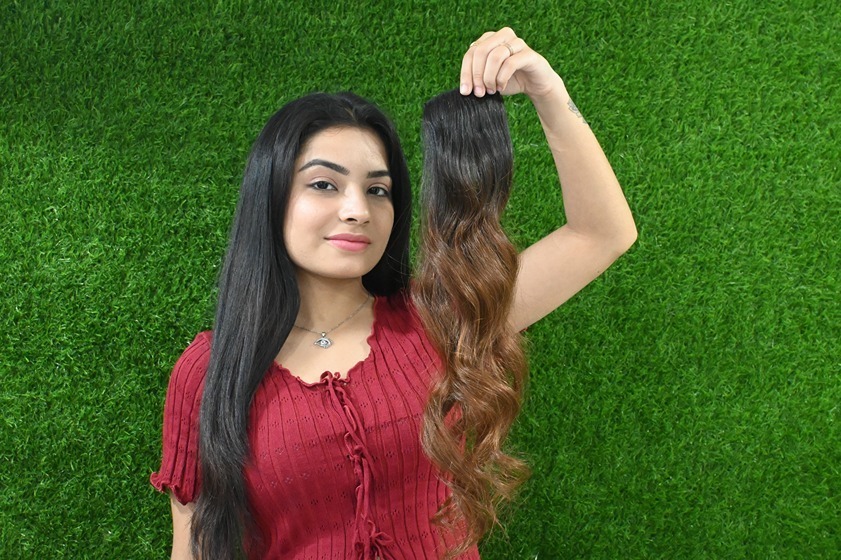Hair Toppers vs. Wigs: Which Is Better for Hair Thinning?
Hair thinning is a reality many women face, whether it’s due to genetics, hormonal changes, postpartum shedding, stress, or medical conditions. And while hair loss can feel overwhelming, today’s hair solutions offer more options than ever. Two of the most popular choices are hair toppers and wigs—but which one is right for you?
This blog will explore the pros and cons of hair toppers vs. wigs for thinning hair. We’ll help you understand how each works, who they’re best suited for, and which option could provide the most comfort, coverage, and confidence depending on your level of hair loss.
What Is a Hair Topper?
A hair topper is a lightweight, versatile hairpiece designed to cover specific areas of thinning hair, usually at the crown, top, or front of the scalp. Toppers come in various base sizes and are secured to your natural hair with built-in pressure clips.
Think of a hair topper as a partial solution—it blends with your natural hair to add volume and coverage exactly where you need it, rather than covering the entire head.
What Is a Wig?
A wig is a full-coverage hairpiece that replaces or covers all of your natural hair. Wigs are worn by individuals experiencing more extensive hair loss or by those who want complete styling freedom and full scalp protection. They come in various types, including lace front, monofilament, and full lace wigs, and can be made from synthetic or human hair.
Wigs can completely transform your look and are designed to provide full coverage from hairline to nape.
Hair Toppers vs. Wigs: A Detailed Comparison
Let’s break down the key differences to help you decide between a hair topper and a wig for your specific needs.
1. Level of Hair Loss
- Hair Toppers are ideal for women experiencing mild to moderate hair thinning, particularly at the part line, crown, or top of the head. If you still have healthy hair around the sides and back, a topper can blend seamlessly with your natural strands.
- Wigs are better suited for moderate to severe hair loss or complete hair loss due to conditions like alopecia or chemotherapy. They provide full coverage and don’t rely on existing hair for support or blending.
✅ Best Choice:
- Light to moderate thinning? Go for a topper.
- Widespread or full hair loss? Opt for a wig.
2. Comfort and Breathability
- Toppers are typically smaller and lighter than wigs. They allow more airflow to the scalp and can be worn comfortably for longer periods, even in warm weather.
- Wigs provide full coverage, which means they can sometimes feel warmer or heavier, especially in the summer or during physical activity. However, newer cap designs, like lace or monofilament, offer improved breathability and comfort.
✅ Best Choice:
- For all-day comfort and breathability, especially in hot climates, toppers have the edge.
3. Natural Appearance
- Hair Toppers blend with your existing hair, which can result in a very natural look, especially if matched correctly in color, texture, and density. High-quality silk base toppers offer a realistic scalp effect.
- Wigs, especially lace-front or monofilament wigs made from human hair, can look incredibly realistic. However, improper fit or unnatural hairlines can sometimes make a wig more noticeable if not styled correctly.
✅ Best Choice:
- If you have enough natural hair for blending, toppers can look more seamless.
- For full transformations or baldness, wigs offer uniform style control.
4. Styling Freedom
- Toppers allow you to part and style your natural hair along with the hairpiece. You can curl, straighten, or braid both together, but the topper needs to match your hair’s condition.
- Wigs offer the freedom to try different lengths, textures, and colors without changing your natural hair at all. You can wear a short bob one day and long waves the next.
✅ Best Choice:
- Want to experiment with bold styles? Choose a wig.
- Prefer blending with your hair for a subtle volume boost? Go with a topper.
5. Maintenance and Care
- Hair Toppers require regular maintenance just like natural hair. They need to be washed, conditioned, detangled, and stored properly. You’ll also need to maintain your natural hair underneath.
- Wigs need their care routine, but they save you from the daily styling of your hair. You can rotate between wigs to extend their life.
✅ Best Choice:
- Want a lower-maintenance styling option day-to-day? Wigs may suit you better.
- Don’t mind blending and caring for both topper and natural hair? Toppers are great.
6. Security and Fit
- Hair Toppers attach using clips and require some amount of natural hair to grip onto. When properly secured, they are stable and safe for daily activities, but not ideal for high-impact sports or swimming.
- Wigs offer full-head security and are available with adjustable straps, combs, and even glue or tape options. Many women find wigs more secure for activities or public appearances.
✅ Best Choice:
- For active lifestyles or full-day security, wigs provide better coverage.
- For casual wear or light activity, toppers stay in place just fine.
7. Cost
- Hair Toppers are generally more affordable than full wigs because they use less hair and have a smaller base. Prices vary based on hair quality, cap construction, and length.
- Wigs, especially high-quality human hair wigs with lace or silk caps, can be more expensive but offer full coverage and long-term use.
✅ Best Choice:
- Budget-friendly and partial coverage? Choose a topper.
- Willing to invest in full coverage and styling freedom? A wig may be worth it.
Final Thoughts: Which One Is Right for You?
Choosing between a hair topper and a wig depends on how much hair you’ve lost, your lifestyle, comfort preferences, and your styling goals.
- Choose a Hair Topper if you:
- Have mild to moderate thinning at the top or crown
- Want to blend the piece with your natural hair?
- Prefer a lightweight, breathable solution.ns
- Are you looking for a more affordable hair solution?
- Have mild to moderate thinning at the top or crown
- Choose a Wig if you:
- Have significant hair thinning or complete hair loss
- Want full coverage and styling flexibility.
- Prefer to protect your natural hair entirely.y
- Need a secure option for public or professional settings.
- Have significant hair thinning or complete hair loss
No matter which you choose, both toppers and wigs can help restore confidence and give you back the freedom to enjoy your hair again. The key is to invest in high-quality materials, get a proper fit, and maintain your hairpiece with care.

